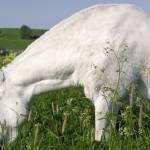Colic Risk Factors

Equine colic is loosely defined as abdominal pain. The causes are numerous, and the signs of discomfort (rolling, kicking at the abdomen, pawing, sweating) are familiar to most experienced horse handlers. Colic is one of the most common health emergencies, with an incidence of just over 9 cases per 100 horses in an average year. It is a leading reason for surgery and a frequent cause of death in horses.
Years of research have been devoted to sorting out management practices associated with causes of colic. Careful examination has led to some general conclusions about factors that may put horses at increased risk. Below is a summary of trends identified by several independent studies.
Breed Some studies identified Standardbreds, Thoroughbreds, Arabs, and warmbloods as having more frequent colics than other breeds, while other studies found the opposite was true. There are no proven trends.
Age There is some evidence that more colics occur in horses between the ages of two and ten.
Consider: these are the years of heavy training and performance. Horses may be under stress from frequent travel, competitions, and changes in schedule.
Use One study showed a higher risk of colic in eventers than in horses used for other sports. Another indicated that colic was more common in breeding stock than in pleasure horses. Consider: colonic twists are common in broodmares, and heavy lactation may induce dehydration or electrolyte imbalance.
Pasture/stall Horses pastured 24 hours a day have low rates of colic, and risk rises as stall time increases. Consider: stalled horses may get less exercise, eat less fresh forage, and be under increased stress from boredom and lack of companionship.
Caregiver Horses cared for by owners had less colic than horses cared for by trainers or managers.
Consider: horses cared for by a trainer are somewhat more likely to be under stress because of exercise schedule, decreased turnout, and a high-grain diet.
Concentrate portion of diet Any inclusion of grain or concentrate increased colic risk over forage only diets. Risk was greater as the amount of concentrate increased, even if the concentrate was split into several feedings per day. The highest risk was seen when horses ate pellets; a sequentially decreased risk was noted with consumption of whole grains (oats, barley), sweet feed, and a combination of whole grains and processed feeds. Horses that were given more or less than their normal grain ration, a different type of grain, or any amount of moldy grain had increased risk of colic.
Consider: many horses in heavy work need to consume grain or concentrates to meet their energy requirements. Risk can be diminished by building the diet around forage and feeding concentrates only as needed. Providing part of the calories from fat (oil or rice bran) helps to reduce dependence on grain.
Forage portion of diet Horses getting 100% of their forage from grazing had the lowest incidence of colic. Horses that had hay added to their diet in the previous two weeks were at higher risk, as were horses starting into a new batch or a different type of hay. Orchard grass hay was linked with colic more frequently than alfalfa, coastal, or Bermudahay. Hay from round bales was associated with an increased colic risk. Feeding hay or grain on the ground was not identified as a colic risk factor.
Water Water deprivation increased colic risk. Stall-kept horses with automatic waterers had more colic cases than horses watered from buckets.
Consider: it is difficult to keep track of water consumption with automatic waterers, so an owner might not know if a horse had stopped drinking or had decreased its water intake. Horses should always have access to fresh, clean water.
History of previous colic Horses that had been treated for colic were more likely to have another episode than horses that had never suffered from colic.
Consider: management strategies that led to the first colic could, if not modified, leave the horse at risk for further episodes. If colic surgery was done, adhesions or other complications could lead to another attack.
Other factors Risk was somewhat higher for horses that had stable vices; were nonagressive or at the bottom of the herd’s pecking order; grazed rocky soil; were given more than two types of supplement; were fed bran either daily or weekly; had been given antibiotics, bute, or other drugs in the previous 30 days; had been dewormed in the previous two weeks; or had health problems other than colic.
What does this information mean in terms of feeding and managing horses?
• Colic can occur even in the most carefully managed horses.
• Anything that changes a horse’s routine may be linked to colic. Feeding changes (kind, amount, timing, or sequence) seem to be the most significant, possibly because the horse’s digestive tract is exquisitely sensitive to disruptions in microflora, lactic acid concentration, proportion of volatile fatty acids, or pH. Horse owners should avoid change as much as possible and should make necessary feeding changes gradually over a period of several days or weeks.
• It is important to realize that, while some factors are associated with an increased risk of colic, these factors do not necessarily cause colic. For instance, although using an automatic waterer is associated with a higher risk of colic, this practice does not cause a horse to colic, and watering from a bucket will not prevent colic. Owners and managers need to evaluate management practices in light of the known risk factors, considering each factor as it relates to an individual horse’s age, work, metabolism, and feeding plan.
• There are limitations to any study that considers all types of colic as the same illness.
Conclusions that apply to one type of colic may have nothing to do with other kinds.








